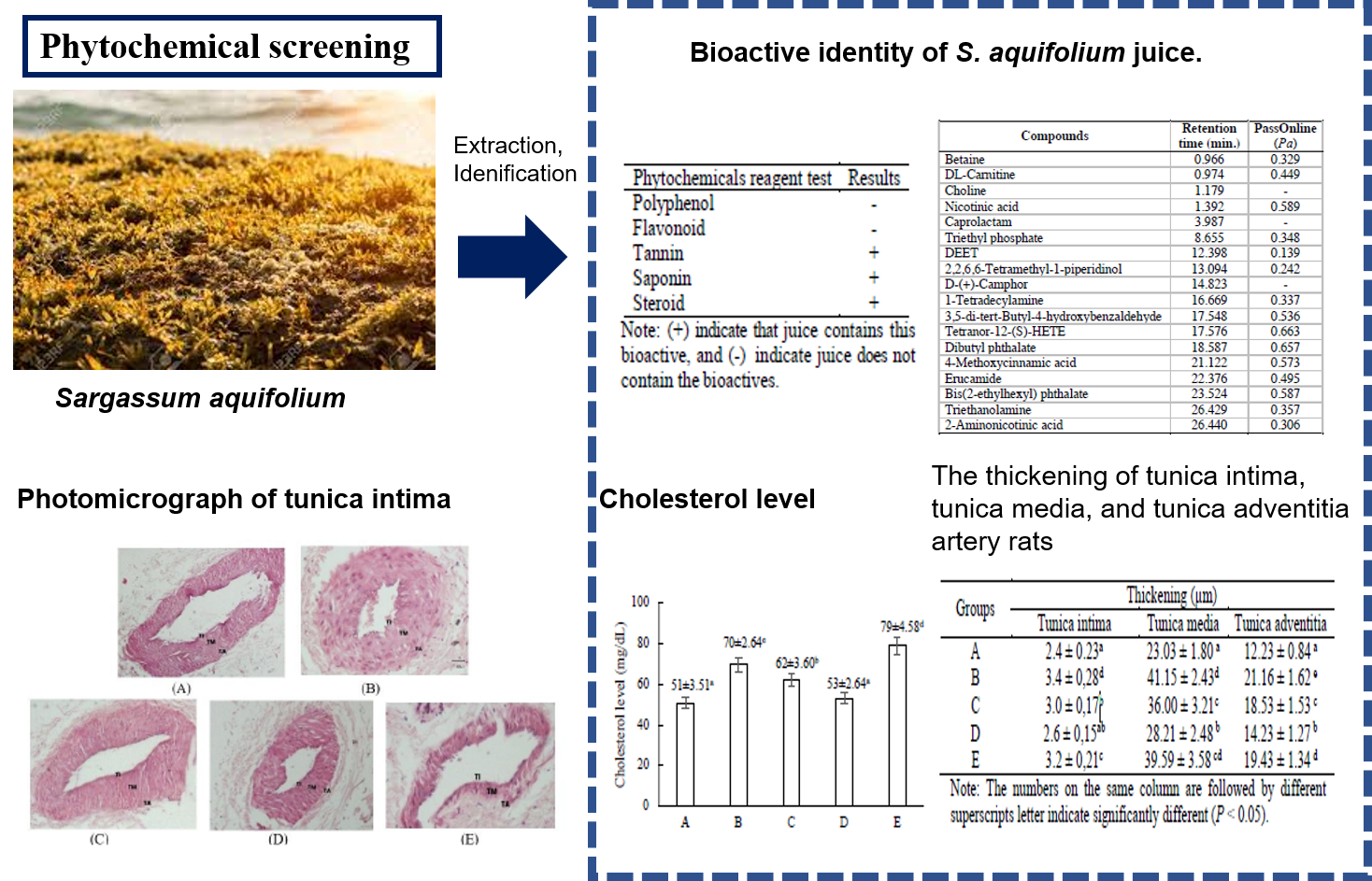Sargassum aquifolium Extract Prevents Elevated Cholesterol Levels and Blood Vessel Thickening in Rats Fed an Atherogenic Diet
Abstract

Hypercholesterolemia is a health disorder in which cholesterol in the blood increases beyond normal limits. This disorder chronically can cause atherosclerosis. Sargassum aquifolium contains bioactive that can prevent an increase in blood cholesterol levels. This study aimed to prevent the increasing cholesterol levels and changes in the blood vessel profile of rats fed an atherogenic diet by S. aquifolium extract. S. aquifolium was obtained from Ekas Bay. Rattus norvegicus 2-3 months ages used in this study. Normal rats were fed an atherogenic diet for four months to produce an animal hypercholesterolemia model. The phytochemical profile was screened based on the Harborne method. Identity of bioactive determined by HPLC-HRMS. The parameters observed were cholesterol levels and blood vessel profiles. The juice of S. aquifolium contained steroids, saponins and tannins and their bioactive showed anticholesterolemic. Rats given an atherogenic diet had increased cholesterol levels. Administration S. aquifolium juice twice a day can reduce cholesterol levels and prevent the thickening of the aorta and arteries. In conclusion, S. aquifolium juice contains bioactive compounds and administration of S. aquifolium juice twice a day prevents an increase in cholesterol and damage to the aortic and arterial profiles.
References
[1] Collado A, Domingo E, Piqueras L, Sanz M-J, Int. J. Biochem. Cell Biol. 2021, 139, 106066.
[2] Grundy SM, Circulation, 2013, 128: A603.
[3] Chan M-Y, Zhao Y, Heng C-K, Integr Physiol, 2008, 16: 972-978.
[4] Dritsas E, Trigka M, Sensors, 2022, 22 (14): 5365.
[5] Ahmadi A, Argulian E, Leipsic J, Newby DE, Narula J, J Am Coll Cardiol. 2019, 74 (12): 1608–1617.
[6] Douglas G, Channon KM, Medicine, 2014, 42(9): 480-484.
[7] Hunninghake DB, Maki KC, Kwiterovich Jr PO, Michael H, Davidson, Dicklin MR, Kafonek SD, J Am Coll Nutr, 2000, 19(3): 351-360.
[8] Cote I, Sock ETN, Levy E, Lavoie J-M, Eur J Nutr, 2012, 52: 1523-1532.
[9] Kadi A, Oseana, 2005, 30: 19-29.
[10] Firdaus M, Nurdiani R, Abadi AF, and Regina EM, IOP Conf. Ser.: Earth Environ. Sci. 2021, 860: 012065
[11] Kumar T, Lakshmanasenthil S, Geetharamani D, Marudhupandi T, Suja G, Suganya P, Int J Biol Macro, 2015, 72: 1044-1047.
[12] Firdaus M, IOP Conf. Ser.: Earth Environ. Sci. 2021, 695: 012050
[13] Harborne JB. Phytochemical Methods. A Guide to Modern Ways of Analyzing Plants. Translation of K. Padmawinata & I. Soediro, 1987, ITB Publisher, Bandung.
[14] Firdaus M, Nurdiani R, Rivai B, Hemassonida WH, Badzliyah A, Sugiat NK, J Appl Pharm Sci, 2022, 12: 132-139.
[15] Shikov AN, Narkevich IA, Akamova AV, Nemyatykh OD, Flisyuk EV, Luzhanin VG, Povydysh MN, Mikhailova IV, Pozharitskaya ON, Front Pharmacol, 2021, 12, 697411.
[16] Firdaus M, Karyono SS, Astawan M, J Ilmu Hayati, 2009, 21, 60-65.
[17] Baleta FN, Bolaños JM, Ruma OC, Baleta AN, Cairel JD, J Med Plant Stud, 2017, 5, 382-387
[18] Nnamdi UB, Onyejiuwa CT, Ogbuke CR, Tech Eng Syst J, 2020, 5: 485-492.
[19] Sardari RRR, Prothmann J, Gregersen O, Turner C, Karlsson EN, Molecules, 2021, 26, 43
[20] Zaharudin N, Staerk D, Dragsted LO, Food Chem, 2019, 270: 481-486.
[21] Zhuang B, Ramanauskate G, Koa ZY, Wang Z-G, Science, 2021, 7, eabe7275
[22] Gomez-Guzman M, Rodriguez-Nogales A, Algieri F, Galvez J, Mar Drugs, 2018, 16: 250
[23] Renita RE, Narayanan R, Cypriyana J, Samrot AV, Biocat Agric Biotech, 2020, 28: 101763
[24] Kim S-N, Lee W, Bae G-U, Kim YK, Biochem Biophysic Res Comm, 2012, 424: 675-680.
[25] Murwani S, Ali M, J Kedokteran Brawijaya, 2006, 22: 119–125
[26] Wardani S, Dissertation Universitas Brawijaya, 2013
[27] McGill HC, Am J Clin Nutr, 1979, 32: 2664-2702
[28] Matanjun P, Mohamed S, Muhammad K, Mustapha NM, J Med Food, 2010, 13: 4
[29] Alaydrus S, Pagal FRPTD, Ervianingsih, J Sains Kesehatan, 2020, 2: 405–412.
[30] Thomas J, Shentu TP, Singh DK, 2012, IntechOpen, London.
[31] Firdaus M, Chamidah A, Nurcholis AR, Yulaikah S, Anggraeni PY, Suryanata W.A., Hardiansyah R, Pharmaciana, 2017. 7(2): 195-204.
[32] Widjaja SL, Advani N, Tambunan T, Sari Pedia, 2016, 9: 285-92.
[33] Lisabilla FA, Doctoral Dissertation, 2018, Universitas Brawijaya.
[34] Hsu YW, Tsai CF, Chen WK, Huang CF, Yen CC, Food Chem Toxicol, 2011 49: 2624-2630.[35] Dwitiyanti D, Sunaryo H, Kania IR. Pharmacy, 2015. 12(2): 153-163.
[36] Firdaus M, Astawan M, Muchtadi D, Wresdiyati T, Waspadji S, Karyono SS, JPHPI, 2012, 15(2): 148-155.
Refbacks
- There are currently no refbacks.

This work is licensed under a Creative Commons Attribution-NonCommercial 4.0 International License.








